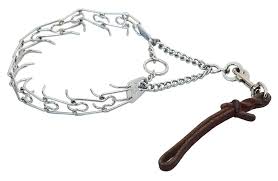
Do you want to just look kind, or do you want to actually BE kind?
When I first started working with dogs, I noticed that many owners just wanted to look kind, letting their dog be dragged around on a harness while barely engaging in any real communication. They think people will be impressed, but all I saw was a lack of connection and a complete disregard for proper guidance. On the other hand, when you actually commit to being kind, the prong collar changes everything. This tool is designed to deliver gentle corrections that direct your dog to follow commands without hurting, choking, or causing damage.
I remember using a prong collar on a particularly stubborn sled-type dog who pulls constantly; he ignores traditional methods, but with a properly fitted prong collar, I could deliver extremely controlled guidance. The process is easy once you understand it—it enables the dog to respond calmly while wearing the collar and even a prong cover or bandana for aesthetics if looks are a concern. Some people hesitate and think it’s harsh, but when you buy into the right approach and see your dog’s responsiveness, it’s clear that actually being kind is far more effective than simply appearing so. The engagement grows, the pulling diminishes, and your bond strengthens while your dog feels safe and understood.
Confession time (Full disclosure & transparency)
I have to admit, I was once one of those well-meaning people who had no clue about the prong collars and how they work. I thought they were cruel, nasty, and only associated with hoodlums or fighting dogs. I believed they were for big, aggressive dogs and for people who didn’t train properly. I was totally, completely uneducated and had false assumptions about this tool. Over time, I learn that my thoughts were wrong, and I made mistakes by judging without understanding. Using a prong collar correctly can actually help dogs and owners alike, and now I get the truth—it’s not about cruelty, it’s about proper guidance, not used recklessly, and can improve training if applied wisely. I’ve lived this experience and realized that the same assumptions I held could mislead people, but once you take the time to learn, you actually see the benefit.
Clear & easy communication with power steering
When it comes to training dogs, clear and calm guidance is essential. Using a prong collar allows owners to motivate their dog in a gentle, subtle way without choking or gagging. Unlike regular collars, buckle, martingale, leader, or halti, the prong collar distributes pressure evenly around the neck, protecting the trachea and larynx while preventing injury. By applying just the right amount of force with leverage, owners can guide their dogs safely, helping them walk politely and respond calmly. This approach relates to how dogs naturally train, providing comfort and ease while avoiding damage or dangerous injuries. It’s especially important for canine cervical issues, as noted in literature from chiropractor Daniel Kamen, who emphasizes that upper cervical subluxations are less frequent when pressure is evenly distributed around the neck.
With proper use, prong collars also prevent yanking, cranking, and excessive pulling, giving owners control while ensuring safety. Unlike harnesses, which are sometimes preferable for casual walks, a prong collar is designed for effective restraint and guidance. Adjusting it well allows you to train your dog sensitively, keeping the air supply unobstructed and reducing incidences of injuries. When applied correctly, it works like power steering, letting you point your dog in the right direction, calmly managing pressure, and providing the comfort necessary for confident, safe, and polite walking.
It’s important to be kind to dog owners too
Training a dog isn’t just about them—it’s about the owners as well. Using a prong collar can make walking safer and less painful for both, preventing dangerous situations caused by pulling, lunging at squirrels or bikes, and other behavioural problems. Many people have fallen, broken limbs, dislocated shoulders, or gotten injured while trying to manage their dog. A prong collar used correctly is an effective tool that helps communicate and direct the dog properly, keeping everyone safe and reducing frustration. It’s amazing how a simple, kinder, and easy approach can make life less stressful while establishing good habits and responsibility for both dog and owner.
When applied naturally, the prong collar supports training, ensures exercise is productive, and protects the dog from predators or wildlife while making the experience pleasant for humans too. It can be amazing to see a dog lead calmly, respond to host commands, and enjoy the walk without bad habits taking over. By being kind to the owners, the tool helps everyone enjoy the changing journey of dog training correctly, turning difficult walks into moments of connection and safety.
How to use a prong collar
Using a prong collar correctly starts with fitting it snug around the neck, just behind the ears, and attaching the leash to the swivel or O-ring. This ensures safety while you gently begin leading your dog. Start indoors in a quiet, familiar space with minimal distractions. As you walk or practice guiding, pay attention to the sensation of pressure and release, making sure the collar is maintained correctly without being taut. Allow some slack so your dog doesn’t pull too hard, and stop or correct gently if there’s resistance. Short sessions with frequent breaks help your dog learn to move in the right direction, while turns and small adjustments teach teamwork and reinforce good heel position.
Once the dog is comfortable, gradually move outside to walk on cement, asphalt, or grass, while keeping distractions low. Use subtle cues like pops of the leash, lifts, or pulls to remind your dog of the correct position, and guide them proactively. The goal is to succeed in perfecting the heel, help your dog feel confident, and maintain a smooth walking experience. Start slowly, short distances first, and then increase time as your dog learns to move ahead safely. The beauty of this method is how it allows both dog and owner to succeed calmly, while reinforcing the important skills of direction, control, and proper conditioning.
Heel position – You drive & your dog is a passenger
When training your dog, getting the heel position right is essential. Think of your dog as a passenger while you are driving; their nose stays just behind you, following your pace calmly. This helps your dog relax and not worry about what’s coming. As the handler, you watch for signs, turns, and speed, decide the route, and direct your dog safely while advocating for them when other dogs, skateboards, squirrels, or people are nearby. This mode teaches control and patience, letting your dog enjoy the walk while following instructions, and creates a smooth, safe, and confident walking experience for both of you.
Lead calmly, safely & effectively
Using prong collars is one of the most helpful tools to communicate with your dog calmly, safely, and effectively. Whether you have pooches who are pullers or massive dogs, the prong collar provides clear guidance and direction without hurt. It’s important to lead your dogs while supervising and never leave the collar unattended. The tool works like a new language, teaching your dog to respond clearly without shouting, making walks fun and allowing you to enjoy the experience while being amazed at the results. I personally prefer the Herm Sprenger brand, known for high quality prongs, sharpness that isn’t harmful, and rust-resistant metal versions that even come in different colours, bling, or belt styles. With patient, fantastic use, this new tool helps tiny or large dogs behave safely, giving owners confidence and dogs a clear understanding of commands.
Do vets recommend prong collars for dogs?
Many veterinary behaviorists debate whether prong collars are humane or necessary for training dogs. Some argue that these devices can cause physical or mental harm if used incorrectly, while others see them as helpful when applied properly. From my experience, when applied with care, prong collars can prevent bad habits and make walks better and safer, and I’m thankful that I learned how to use them correctly in the past. Although not all vets recommend them, understanding their proper use and respecting your dog’s limits ensures you cause minimal stress and achieve effective training without unintended harm.
Are prong collars banned in the UK?
In the UK, prong collars are not illegal, and it’s true that many people still sell them as gentle training tools. Sadly, some dog owners believe the opposite, thinking these collars should be banned, but in reality, that is not the case. I have personally seen dogs respond well when used properly, and it’s important to see the prong collars as helpful tools rather than harmful. If you want to train your dog safely and effectively, state your approach clearly and use the collars responsibly.
What are the benefits of a prong collar for a dog?
A prong collar gives the handler precise control over the dog by evenly distributing pressure around the neck, preventing injury while guiding the dog effectively. The gentle correction mimics the natural corrections that pack leaders use, helping dogs understand what is expected without fear. Although the appearance can seem intimidating at first, in practice, it provides a safe and structured way to give the dog the guidance needed for training. From my experience, using a prong collar properly allows owners to teach dogs efficiently while reinforcing trust and cooperation, making walks and training sessions calmer and more effective.
Will a prong collar stop pulling?
A prong collar works by putting pressure on multiple points around the dog’s neck, exactly where it is supposed to stop pulling without causing unnecessary pain or discomfort. When adjusted within safe limits, it gently reminds the dog to follow commands and teaches them not to pull, while preventing injuries that could cause long-term problems. The look of the prong collar might seem intimidating, but when used correctly, it stops pulling effectively while guiding the dog safely and calmly.
What’s the right age to use a prong collar?
The right time to start using a prong collar depends on your puppy’s size and behavior. I usually recommend introducing the collar when your puppy is big enough to pull but still young, so they can learn good habits early. Typically, this starts around the time your dog begins exploring the world more confidently. Even a little puppy can benefit when the prong collar is used safely, and beginning training at the right time sets the foundation for a well-behaved dog as they grow.
